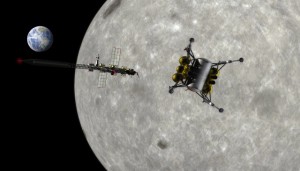Space Exploration Sets Sail on Lunar Water
The recent finding of water on the Moon has generated considerable comment in the space community.

Water is an extremely useful substance in space. The recent finding of water on the Moon has generated considerable comment in the space community; a quick search on Google using the phrase “lunar water” returns over 7.66 million hits. Lunar water’s significance lies not in its role as a medium for the presence of extraterrestrial life but rather in its potential to support terrestrial life—ours—as humanity moves beyond Earth. The Moon is the port from where we will navigate—the safe harbor where we will learn how to live and work productively in space and from where we will set sail into our Solar System, thereby ensuring the survival of our species.
The three principal uses for this water are life support, energy storage, and rocket propellant.
We can easily imagine drinking water. We need about 2 liters of water per day under ordinary circumstances. Water is also a constituent of food, both unprepared and preserved, adding at least another liter to that total. In addition to consumed water, we can also use water to make oxygen, replenishing the air we bring with us to create a breathable atmosphere. Water is over 85% oxygen by weight and the liquid is easily broken into its constituent gases by passing an electrical current through it.
Another way that water supports life is by offering shielding and protection against solar and galactic cosmic radiation. Water harvested from the Moon can fill the outer jackets of surface habitats, protecting not only human life and technology within it, but also the plants that we will want to grow there, both for food supply and carbon dioxide scrubbing of the habitat air. Thus, water supports life on the Moon as both a consumable and as a building material.
A second main use of water is less often considered. We can break down water into its component gases using electricity, but the process can also be reversed – hydrogen and oxygen gas can be combined to generate electricity in a device called a fuel cell. When these gases combine, they generate electrical energy and make water as a by-product. This technique was used in the Apollo spacecraft for power and water production. When combined with another technique to generate electrical power (e.g., arrays of solar cells or a nuclear reactor), we make a completely reversible, self-sustaining power and water system. Thus, the water becomes a medium of energy storage – during lunar night, we combine hydrogen and oxygen to make water and electrical power while during the daytime, we reverse the process by using electrical power generated by sunlight to disassociate the water back into its constituent gases. Such a rechargeable fuel cell system enables permanent, sustainable human presence on the Moon.
The third important use for lunar water is for the production of rocket fuel. Liquid hydrogen and oxygen are the most powerful chemical rocket propellants known. By manufacturing rocket propellant from lunar water, we make the Moon a refueling station and logistics depot in space. The critical value of this ability is that such rocket fuel not only permits our routine access to and from the Moon, but also enables access to any other point in cislunar space (the volume of space between Earth and Moon.)
All satellites reside in cislunar space. Numerous remote-sensing satellites are found in low Earth orbit. GPS elements reside in moderately high (few hundred kilometer) orbits. Communication satellites are found at geosynchronous orbit, 35,000 km above the Earth. Other specialized satellites occur at different altitudes. At present, we cannot access these satellites with either human or robotic spacecraft. So we design, build and fly these space assets, use them for a time then abandon them, replacing them as needed with new satellites—at great cost. The ability to reach valuable space assets routinely with people and machines allows us to change the way we conduct business in space. Instead of the current “fly and throw away” template, we can build extensible, maintainable and upgradeable systems.
Very large, distributed space systems will enable new capabilities, such as global communications using hand held cell phone-sized equipment, anywhere in the world at any time. New remote-sensing platforms can be built to look at any corner of the globe at any wavelength in unprecedented detail. Telescopes built on the Moon’s far side, where they will be shielded from Earth’s radio noise, can scan the universe in new areas of the spectrum. These and many more capabilities are enabled by a cislunar transportation system and will vastly improve life on Earth.
By understanding and using the resources of our Moon, we can push out to the stars. An abundance of water on the Moon fundamentally allows us to change the rules of exploration and spaceflight to our advantage. We stand at the threshold of a new understanding of how the Moon evolved and works—and works to humanity’s advantage.
/https://tf-cmsv2-smithsonianmag-media.s3.amazonaws.com/accounts/headshot/blog_headshot_spudis-300x300.jpg)
/https://tf-cmsv2-smithsonianmag-media.s3.amazonaws.com/accounts/headshot/blog_headshot_spudis-300x300.jpg)